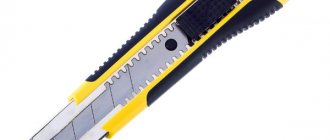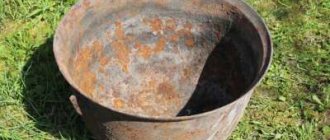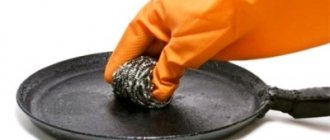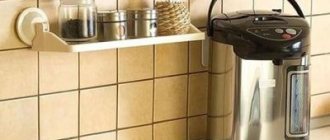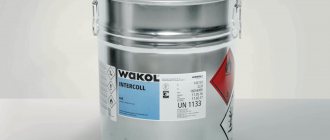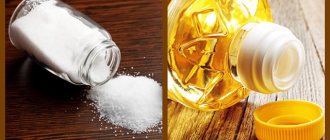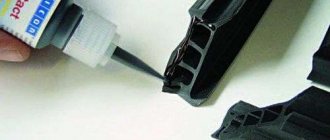Axton foam cleaner, 0.5 l. Photo by Leroy Merlin
One of the positive characteristics of polyurethane foam is its excellent adhesion to many building materials . But when polyurethane sealant gets on surrounding objects, floor coverings, clothes and hands, this advantage turns into a disadvantage. Since getting rid of contaminants will not be easy. There is a wide range of products for removing fresh and dried stains, but cleaners are most effective.
Composition and characteristics of the remover
In accordance with GOST, the cleaner is a colorless transparent mixture of organic solvents and propellant gas . Used to remove remnants of polyurethane foam, to wash and clean the gun, to wash polyurethane sealant from clothing and skin surfaces. Production is carried out in accordance with the rules of GOST , which prescribes the safety of use and the possibility of use without any special protective equipment for the respiratory tract. In addition, the standard specifies the degree of flammability and explosion hazard during prolonged heating.
Therefore, when purchasing a purifier, it is necessary to check the availability of a certificate of conformity. The packaging must contain the following designation - “ ROSS VE.AD83.H04410 ”. If it is, then the product passes all the necessary tests.
Manufacturers produce a significant range of products designed to remove foam from various surfaces. Despite the variety of options, the components present in the products are largely similar. The main elements are:
- the basis is acetone or another element that is safer in characteristics and ensures the removal of hardened foam;
- various industrial solvents;
- compressed gas , which facilitates the release of the cleaner from the aerosol can;
- Special polymer additives may be present .
Work on removing polyurethane sealants from various surfaces should be carried out taking into account the characteristics of the cleaner. It is recommended to know them before starting to work with foam:
- due to the components present in the composition, cleaners are easily flammable , which requires applying the product away from open sources of fire;
- options for cleaners for removing fresh foam than for hardened polyurethane, since the second type of pollution is more difficult to remove;
- The safety of the products has been confirmed by tests, but if they come into contact with the skin, allergic reactions may occur;
- the use of personal protective equipment is not necessary, but experts recommend the use of goggles, a respirator and gloves;
- Before performing work, it is recommended to study in detail the instructions , which provide information on application and storage conditions.
How is cleaning done?
How and with what to wash foam from hands?
This question is most often found on the Internet, since most inexperienced builders begin working with foam without protecting their hands with gloves.
If such a situation occurs and fresh polyurethane foam has just come into contact with the skin of your hands, you should immediately take the following measures:
Foam can be removed from the skin of your hands in different ways, depending on its amount and degree of hardening.
- The first thing to do is to carefully remove the bulk of the foam, without spreading it to adjacent areas of the skin. You can use a spatula for this. If you have an assistant nearby, you can use two spatulas, picking up the foam from both sides.
- Immediately after this, one of the professional products should be applied to the remaining foam and immediately wiped off along with the polyurethane with a dry cloth. If it was not possible to remove all the foam in one approach, the procedure should be repeated. Then wash the cleaned area with soap and water and a brush.
- If the foam gets on a large area of skin, you should take a cloth, apply vegetable oil to it and carefully, slowly, try to collect the foam from the edges to the center. After this, you need to take a narrow spatula and try to collect most of the foam with it, then apply a solvent to the fabric and begin to scrub off the remaining polyurethane. The skin should then be washed with soapy water.
If the foam on the skin of your hands has already hardened, experts who have encountered this problem advise taking the following measures:
- An effective and fairly quick remedy, and most importantly safe, is the use of saline solution. To soften the frozen foam, hold your hands in salt water for 10–15 minutes. After this, you need to clean off the foam using pumice. Then just dry your hands with a towel and lubricate with an emollient. Regular baby cream or Vaseline oil is suitable for this.
“Dimexide gel is affordable and softens dried foam on hands well
- "Dimexide-gel" is a medication and can be bought at any pharmacy. The gel has the property of softening polyurethane foam, making it easily removed from the skin.
Baking soda and vegetable oil are used for various needs, including for cleaning foam from skin.
- Vegetable oil and soda. It will take some time for this mixture to act on the hardened foam, since it will not work instantly. To prepare the “cleaner” you will need five tablespoons of soda, to which you need to add oil heated to a warm state, and then prepare a liquid slurry from the two components. The soda in this product will act as an abrasive.
The mixture is applied to the contaminated area of skin and rubbed into it. Then it is applied to a cotton swab and applied to the hand, covered with a clean cloth and closed with a plastic bag or cling film. You need to keep this lotion for 25-30 minutes. Then you need to remove it, wipe the contaminated area again, and then wash it with warm water and soap.
- Kerosene, acetone or white spirit. Before using these products, it is necessary to remove most of the foam from the skin. After this, you should moisten the cloth in one of the mentioned solvents and rub your hand with the remaining foam. However, these products are not suitable for everyone, as they can cause an allergic reaction, and this also needs to be kept in mind. These compounds should be used outdoors, as they have a specific odor.
- You can use professional cleaners to dissolve dried foam if you are not allergic to them. Most of the frozen mass should be cut off, if possible, and then apply the product to your hands, wait a few minutes and wipe off the dirt with a cloth. After which you need to wash your hands well with soap.
All these procedures are not very pleasant, so it’s better not to let it get to that point. But it’s even worse if foam gets into your hair during work.
How to clean hair from foam?
If polyurethane foam accidentally gets on your hair, it should be removed immediately, since once it hardens, it will not be possible to clean the mass; in this case, there is only one way out - a haircut.
So, you can clean your hair from fresh foam as follows:
- If the hair is long enough, then it is necessary to separate the contaminated part from the rest of the hair. Using a toothed comb, you need to start combing out the foam, continuing to do this until they acquire relative softness, and they will acquire it when the glued curl is divided into individual hairs. Solvents should not be used, as if they get into your eyes or facial skin, you can get a serious burn.
"Dimexide" will help soften the foam, making it easier to comb out
- If it was not possible to completely comb the polyurethane out of your hair, you should use liquid “dimexide”. It can make the foam softer, which will allow it to be removed completely. This product has an unpleasant odor, but it will not cause any harm to your hair or health.
- At the end of the cleansing procedure, the head should be washed with shampoo several times.
Very important note. Liquid “dimexide” is a powerful anti-inflammatory leaf remedy that very actively penetrates human skin - this is essentially what the “technology” of its medicinal use is based on. But if you use it as a foam solvent, and do not protect your hands with gloves, you can get very unpleasant consequences, since it will “pull” the dissolved polyurethane foam through the skin. Caution and extreme care should be taken!
Removing foam from fabric
The most difficult thing to clean from foam is fabrics, since when it gets on them, polyurethane is immediately absorbed into their fibers. Therefore, contaminant removal is usually carried out in several stages:
Jeans cleaned with liquid dimexide
- If the foam has dried and has a fairly large volume, then first of all most of it should be removed by cutting. You can use a utility knife for this. You must work extremely carefully so as not to “stripe” the fabric itself - a small layer of foam is left on the surface.
- Next, you should use a professional solution to remove dried foam, gasoline, white spirit, kerosene or liquid dimexide. Either of these solvents is applied to the remaining foam and left for five minutes.
- The next step is to rub the fabric until the layer of foam is removed - just as is done during washing.
- For thin fabrics it is better to use “dimexide”, since a real solvent can damage it.
- After cleaning the foam, the clothes should be washed in the washing machine.
It is a little easier to deal with foam that has just hit the fabric and has not yet had time to penetrate its structure. In this case, the item of clothing, as mentioned above, can be placed in the freezer to freeze the foam, after which it can easily be separated from the fabric.
Foam on clothing
If, after freezing and removing the bulk of the foam, a trace of it still remains on the fabric, then it must be treated with a solvent. The item of clothing should then be washed as usual.
Another option to get rid of fresh foam if a small area is contaminated with it is to try to remove it from the fabric with a spatula or an old credit card. The remaining traces of foam can be wiped off with dimexide, gasoline or kerosene. It is not advisable to use acetone, as it lightens the color of the fabric, so it is possible that a whitish spot will remain on it.
How to clean foam from different materials?
For different surfaces, different means are used to clean them from polyurethane foam. For example, if foam gets on a surface made of metal, concrete or stone, then aggressive solvents or professional cleaners are suitable for cleaning it. If it is necessary to remove polyurethane foam from plastic parts or surfaces, it is recommended to use softer compounds - “dimexide” or one of the professional products designed specifically for cleaning plastic.
As mentioned above, the easiest way is to remove foam that has not had time to completely harden and adhere to the surface. When cleaning polyurethane foam from a window sill, door and other objects, you should wear gloves so that you don’t have to scrub it off with your hands later.
Whatever surface the foam gets on, most of it should be removed mechanically using a spatula or a sharp knife. Its remnants are removed using one of the suitable means:
Varnished wood piece contaminated with foam
- Wooden varnished or painted parts can be easily removed from both fresh and dried foam using dimexide. Under no circumstances should you use acetone for this purpose, as it can damage the varnish.
- Uncoated wooden surfaces can be cleaned using professional cleaners, choosing a product depending on the condition of the foam. Then clean the wood with sandpaper and sand it.
- Remains of frozen foam can be removed from a metal surface with vegetable oil, applying it with a sponge and leaving for a few minutes. After such a pause, the contaminated area must be rubbed with a hard dish sponge. To ensure that no greasy stain remains on the metal, the surface will then have to be washed with a soapy solution.
Removing foam residue from a plastic window using a spatula
- Plastic surfaces, in particular PVC windows and doors, should be cleaned with dimexide or one of the professional products suitable for this. When purchasing a cleaning solvent, pay attention to what surfaces it is intended for cleaning.
- There is also a mechanical method for cleaning a plastic surface from frozen foam. Most of it can simply be torn off by hand, and the remaining trace of it can be carefully cleaned off with a metal spatula or blade.
- The remnants of fresh foam that have fallen on the plastic, after removing the main mass with a spatula, can be wiped off with vinegar.
Cutting off polyurethane foam residues from glass
- Glass can also be cleaned without resorting to various solutions and cleaners, using a regular blade, which can easily cut off the remains of hardened foam from a smooth surface.
Foam experimentally applied to linoleum is easier to remove when frozen
- Linoleum and laminate. The foam does not penetrate into the structure of this material, but is well fixed on its surface, especially in cases where the linoleum has a relief pattern. It is better to remove foam from this floor covering after it has completely hardened. The main frozen mass is cut off with a knife, and it is better to remove the remains from the relief coating with Dimexide. The composition is applied to the dirt and left for 15-20 minutes, then wiped off with a cloth. After this, the linoleum should be washed with soapy water.
* * * * * * *
In conclusion, it should be noted that there are quite a few options for getting rid of the foam that gets in. However, if most of it is removed from the surface immediately, before penetrating into the structure of the material, it will be much easier to clean it.
And the best “way to clean” is to not let the foam get on any surfaces where it shouldn’t be.
At the end of the publication, there is a video about available ways to get rid of dirt from polyurethane foam.
Pros and cons of foam removers
The cleaners contain a significant amount of chemical components that soften the polyurethane sealant and, as a result, allow it to be easily removed from various surfaces without harming them. There are options on sale for working with various surfaces ; separate cleaners are suitable for removing polyurethane from hands.
Regardless of the type of product, its use does not cause difficulties for performers of various skill levels in the field of construction. The cleaner promotes a targeted effect on contamination, this is especially true for aerosol products. The main advantage of cleaners in comparison with other products is their high efficiency .
Foam cleaner Penosil 0.34 l. Photo by Leroy Merlin
The main drawback is the aggressiveness of the components present in the composition. As a result, it is necessary to observe safety precautions and follow the instructions provided by the manufacturer. Failure to follow the recommendations and rules can lead to health problems. Choosing a cleaner is also not an easy procedure ; you need to take into account the surface of the base you are working with and the condition of the foam. In addition, it is recommended to test the product on the surface without fail, so as not to aggravate its condition. A significant part of the options have a pungent and unpleasant odor.
Why you should buy a foam cleaner
Polyurethane foam is designed to close all kinds of holes that are discovered during construction work. The material can also increase the thermal insulation properties of the surface. It is often used when installing doors, and during operation it ends up on linoleum or other floor coverings.
When the product is applied to the surface, the layer is liquid, but after it hardens, it changes its volume, and thus the empty space is filled. The layer becomes resistant to various influences. There are disposable and reusable foams.
The material is popular because of its positive properties, but if the composition gets on fabric or skin, it is difficult to wash off. Also, over time, the gun with which the substance is applied becomes dirty, and it becomes impossible to use it in this condition.
For this reason, it is worth purchasing special cleaners that will help solve the problem. You can find many similar compositions on sale.
The material is popular because of its positive properties, but if the composition gets on fabric or skin, it is difficult to wash off.
Types: liquids for removing old foam and more
Today there are several types of special cleaners. Special foam removers are primarily divided into:
Foam cleaner MASTERTEX PREMIUM 500 ml. for removing fresh and hardened foam. Photo by Maxidom
Substances designed to remove fresh (liquid) foam has just been applied and has not yet hardened. Non-concentrated formulations allow you to remove fresh foam from work surfaces, tools, and clothing. These products are also suitable for washing construction guns . After completing the work, it is necessary to unscrew the container with polyurethane foam and release the remaining polyurethane sealant by pressing the trigger. After this, screw a bottle of cleaner onto the gun, pull the trigger and release it as soon as the nozzle flushes, perform the operation several times.
Substances intended to remove dried contaminants . Concentrated compounds with a significant proportion of acetone in the composition soften hardened polyurethane, which makes it possible to subsequently remove it mechanically.
The action of the cleaner is based on the dissolution of foam , which, after applying the product to it, begins to dissolve, decrease in size, collapse, and disappear. However, some stains may remain. When working with frozen contaminants, preliminary mechanical treatment may be required . Using a knife or blade, you need to cut off the top part of the dried polyurethane mass. It is necessary to try to remove as much foam as possible . Anything that cannot be removed mechanically should be softened with a cleaner.
In addition, there is a classification according to the form of release :
1) In aerosol cans of various capacities , containers of 500 ml are most often found. Cleaners in spray form are a colorless substance that is uniform, free from impurities and lumps. The cylinders are equipped with a spray nozzle , for installation of which it is necessary to remove the protective cap. In addition, aerosol cans are suitable for installing a mounting gun. The use of cylinders is characterized by convenience, simplicity, and efficiency . Cylinder cleaners provide quick and effective cleaning of the internal and external elements of guns, container valves, work surfaces and clothing. Easy to apply to hard to reach places .
2) Liquids , for application of which a clean cloth is required. A cloth must be moistened in the product, treated, and soaked in the stain; you can place cotton pads soaked in the product on both sides of the stain. You need to wait a while, most often a few minutes, until the foam softens. After the foam becomes soft, it must be removed from the surface using a sponge or brush.
3) Wipes soaked in a cleaning solution are often classified as a separate category. Wipes are suitable for removing minor stains. Mechanically strong and dust-free wipes are supplied in convenient packaging that protects products from premature drying.
4) They are extremely rare, but they are still available on sale in the form of a paste with a gel-like consistency.
What do you need to remember about the rules for working with foam?
When starting to perform certain operations with polyurethane foam, you should know certain nuances that will help you avoid foam getting on surrounding objects or allow you to remove it without problems.
- The work area - floors, furniture and other objects should be protected with film or newspapers.
When working with foam, it is recommended to protect your hands with gloves.
- Hands should be protected from foam getting on the skin with gloves.
- If you are performing a large-scale task, it is recommended to wear clothes that you don’t mind ruining. Well, or at least use a plastic apron, which you can then throw away without regret.
- Hair should also be protected with some kind of headdress, maybe even an improvised one - a scarf, Panama hat, bandana, etc.
- It is advisable to always have a polyurethane foam remover on hand. The faster you can use it, the better and more “painless” the cleaning of skin, clothing, and other surfaces will be. If the foam has time to set or be absorbed, then it will be much more difficult to clean it.
- If foam gets on any surface, you must try to remove it so that it does not smear. This can be done, for example, carefully with a narrow spatula. Then the remaining dirt must be immediately filled in or wiped with the selected cleaner. It is difficult, and sometimes even impossible, to remove foam that has been spread in a thin layer and has penetrated into the structure of another material.
It is best to remove foam from laminate immediately after contact.
- If the foam hits a surface that does not absorb moisture and other substances in one compact drop, then it would be better to wait for it to dry completely. Once the polyurethane foam expands, it can be easily cut or simply torn from concrete, polished surfaces, and even from some fabrics. However, this method is not suitable for laminate and linoleum, since the foam adheres to these materials very well and can damage the protective layer of the coating when it is torn off. Therefore, it is better to remove it immediately after contact.
- Do not try to wash your hands, tools or any surfaces contaminated by polyurethane foam in the usual way. The foam hardens quickly when exposed to water, and it will then be even more difficult to clean it off.
So, it is best to prevent foam from getting in at all. But, alas, it doesn’t always work out that way. Therefore, it is necessary to use compounds designed to remove foam and use proven methods for cleaning various surfaces from such contaminants.
Manufacturers of fresh and frozen mixture: KUDO and others
To get what you need, i.e. To achieve a high-quality result, you need to choose the right cleaner. The variety of options often complicates the choice; it is difficult for an unprepared performer to understand. Therefore, you should provide information about manufacturers (brands) of quality products:
Polyurethane foam cleaner Tytan Prof Eco 0.5 l. Photo by Leroy Merlin
The Polish brand Tytan offers a professional eco-cleaner for removing uncured foam and glue, designed for cleaning cylinder valves and guns, does not leave marks on PVC and other plastics, comes in a 500 ml aerosol can.
The Belgian ]Soudal[/anchor] offers a cleaner in an aerosol can (500 ml.), which is designed to remove uncured foam, for cleaning guns and canister nozzles, as well as a paste product for removing hardened polyurethane, supplied in a plastic container (100 ml .) complete with brush and plastic spatula.
The Finnish brand Makroflex produces a cleaning liquid for removing uncured foam, characterized by economical consumption and fast action. It is possible to find Soudal cleaning wipes in the assortment of individual supplying companies.
TECHNONICOL (Russia) offers a cleaner from the PROFESSIONAL series for removing uncured foam; the intended materials are metal, wood, and plastic.
Penosil (Estonia) provides a choice of a product for removing fresh foam from work surfaces, tools, clothing, cleaning guns, valves, and a product for removing hardened foam from working tools and various surfaces: PVC, wood, metal.
The Russian brand KUDO offers several product options: professional and household cleaners labeled “FOAM&GUN CLEANER” in 650 ml containers. to remove uncured one-component foam, work with plastic and painted surfaces must be done carefully, it is recommended to do a test; Cleaner labeled “DONEWELL” is a new product for removing fresh polyurethane stains.
Soudal foam cleaner 0.1 l. Photo by Leroy Merlin
In addition, cleaners are offered under other brands:
- Axton , for removing fresh polyurethane from the surfaces of a gun, hands and other objects, based on acetone;
- Kraftool , removes uncured foam from guns, clothing and other surfaces, does not contain freon;
- IRFIX , a universal solution for removing uncured foam and polyurethane adhesive, does not react with PVC and other plastics;
- Masterteks , for removing fresh and hardened foam from the outer surfaces of the gun, valves and caps;
- STAYER , a composition for removing fresh foam from a gun, leather and other surfaces, does not scratch the base, suitable for professional use;
- JETFIX , cleaner in a 450 ml aerosol can. to remove residues of uncured foam and polyurethane adhesive;
- OPPA , for removing uncured foam from tools, clothing and work surfaces.
This is not a complete list of brands; other offers can be found on the suppliers’ websites.
Cleaning up fresh tracks
If the polyurethane foam has not yet dried, remove it with a sponge and a solvent, for example, White Spirit, Cosmofen 5 or ATOLL. The stains will disappear in a few minutes. Varnished and painted objects cannot be cleaned this way, otherwise the caustic composition will ruin the coating. Take two spatulas: pry up the sealant and move it to another spatula. Then wipe the sticky residue with a cloth soaked in warm vegetable oil or vinegar and leave for a few minutes.
When cleaning, do not use water, otherwise the foam will immediately harden and be more difficult to remove. You can try to remove stains from clothes with water, after first removing the excess with a rag.
Anti-foam analogues: Dimexide and others
Many performers prefer to save money and, as an alternative to special means, use improvised pharmacological and chemical substances : vegetable oil, soap solution, soda, vinegar, Cosmofen, white spirit, acetone, kerosene, gasoline, solvents.
Classic laundry soap. Photo by Maxidom
Each of the tools is recommended to be used to solve specific problems. There are separate recommendations for removing foam from doors, others from clothes and hands, and others from plastic windows and other surfaces. In each case, there are products that cannot be used for certain stain removal jobs. For example, Dimexide is an excellent foam remover, but using a pharmaceutical hand cleaner can lead to an overdose and allergic reactions.
White spirit 1 l. Photo by Leroy Merlin
Despite a number of alternative solutions, you need to remember that cleaners show the best results . Therefore, before carrying out work using polyurethane foam, it is recommended to purchase a special product, of a similar brand with polyurethane sealant, to increase efficiency.
Types of foam cleaners
According to the classification, it is possible to identify products that can combat fresh foam. Or for an old coating that has long hardened. The effect of the substance itself is characterized by the dissolution of the foam; after applying the product, it begins to decrease and disappear; some stains may remain, which are removed with a spatula. If you are dealing with an old layer, you may need to work with a knife or a metal brush.
There is also a classification according to the form of release:
- In cans, according to the technical characteristics, it is a colorless substance that is homogeneous. There can be no impurities or lumps;
- Liquid, for application to the area, a rag is soaked in the product, and then the product is processed.
A special gun cleaner for polyurethane foam will not damage the integrity of the ceramic or plastic base, but if you use other options with acetone, damage may occur.
If you are dealing with an old layer, you may need to work with a knife or a metal brush.
Precautions when working with cleaning products
Respirator Source FFP1 with valve. Photo by Leroy Merlin
Cleaners contain various chemical compounds, so safety regulations must be followed:
- carry out work in ventilated areas;
- use gloves, goggles and other personal protective equipment;
- during storage, the cylinder should not be exposed to ultraviolet rays;
- It is prohibited to store and use aerosol cans at high ambient temperatures;
- If a cleaner that is not intended for cleaning foam from hands comes into contact with the skin, the area must be thoroughly rinsed with water and treated with a hypoallergenic cream;
- If the cleaner gets into your eyes, rinse them thoroughly with water and consult a doctor.
Tips and recommendations for use
In order to be able to completely clean polyurethane foam from different substrates, the process itself must be carried out correctly. Therefore, it is worth studying the advice of professionals who have repeatedly engaged in such cleansing after work. It is recommended to follow the tips below:
- Use the substance promptly, it is advisable to begin cleansing immediately;
- When using, protect your eyes by wearing special safety glasses;
- The aerosol form is thoroughly shaken before spraying;
- It is advisable to apply a small amount of the composition to the contaminated area, and also saturate a lint-free cloth with the product;
- Avoid heating the container containing the cleaning agent. Storage should be done in a dark place where ultraviolet radiation does not reach and there are no heating devices nearby.
The use of a new product obliges the specialist to study the instructions for use prescribed by the manufacturer on the packaging, then it will be possible to accurately understand the nuances of the composition.
The aerosol form is thoroughly shaken before spraying.
DIY cleaner
To save money, you can resort to making your own cleaner. The effectiveness of such substances is lower. They are not recommended for washing the gun and removing foam from ceramic and plastic bases. But in all other situations this option has the right to life. To make the product you will need:
- acetone and other organic solvents, acetone can be replaced with liquid Cosmofen;
- means for pumping compressed air;
- metal container with lid and sprayer.
Slightly soluble cleaner Cosmofen 10 1 l. Photo by Leroy Merlin
The sequence of actions is as follows:
- the components are placed in a prepared container, which is filled 2/3;
- the container is closed with a lid;
- Finally, compressed air is pumped into the container, an electric pump is used for this;
- Before using a homemade cleaner, the container must be shaken.
What you need to remove
Getting rid of marks, dried or not, requires a set of tools. Fresh drops are removed using the following means:
- Liquid for washing guns. There are many formulations on the market. The product is only suitable for removing uncured compounds.
- Nail polish remover. It is acetone based.
- Edible vinegar.
- Rags.
To remove already dried foam you will need:
- A special product is “foam cleaner”.
- Brush. Needed for applying solvent liquids.
- Soft rags - rags.
- Medicinal drug "Dimexide".
- Spatula, knife, scraper, dish sponge or unnecessary toothbrush.
Precautionary measures
Construction foam is a highly adhesive product. Therefore, the molecules of the composition penetrate deep into the structure of the material and bind tightly to it. Therefore, it is better to take precautions when working with such a product. The door structure should be protected with a special polyethylene film. This material is secured with tape. The protective film should be applied to those areas where the sealant may accidentally get in contact. This applies not only to the door, but also to the floor. Then you won’t have to rack your brains over how and with what to wash off this product.
How quickly does foam dry?
When, in the process of sealing seams with foam, traces of sealant remain on the door, the question becomes relevant: how quickly the composition hardens, how much time there is to remove the contamination. This parameter depends on the level of temperature and humidity in the room. The thickness of the sealant applied and the surface features also have an impact. It should also be taken into account that the foam can be one-component or two-component. The first compositions harden faster. At high humidity, the sealant completely hardens after 6-9 hours. At sub-zero temperatures, the time of this process increases to 24 hours.

